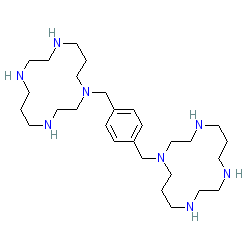GtoPdb is requesting financial support from commercial users. Please see our sustainability page for more information.
|
Synonyms: AMD 3100 | AMD3100 | bicyclam JM-2987 | JM 3100 | Mozobil®
plerixafor is an approved drug (FDA (2008), EMA (2009))
Compound class:
Synthetic organic
Comment: Plerixafor (AMD3100) is an antagonist of the chemokine (C-X-C motif) receptor 4 (CXCR4) [6]. It acts as a stem cell mobiliser.
Ligand Activity Visualisation ChartsThese are box plot that provide a unique visualisation, summarising all the activity data for a ligand taken from ChEMBL and GtoPdb across multiple targets and species. Click on a plot to see the median, interquartile range, low and high data points. A value of zero indicates that no data are available. A separate chart is created for each target, and where possible the algorithm tries to merge ChEMBL and GtoPdb targets by matching them on name and UniProt accession, for each available species. However, please note that inconsistency in naming of targets may lead to data for the same target being reported across multiple charts. ✖ |
|
|||||||||||||||||||||||||||||||||||
| No information available. |
Summary of Clinical Use  |
| Plerixafor is an immunostimulant approved for use as a hematopoietic stem cell mobiliser in the treatment of non-Hodgkin lymphoma and multiple myeloma where autologous stem cell transplantation is necessary. The EMA granted plerixafor orphan status in 2011 as an adjunctive treatment to cytotoxic therapy in acute myeloid leukaemia. Recent studies have suggested the possibility of plerixafor being repurposed for new indications, including recurrent high-grade glioma and pancreatic cancer. Plerixafor is in Phase 1 study (in combination with bevacizumab) for recurrent high-grade glioma (ClinicalTrials.gov identifier NCT01339039). |
Mechanism Of Action and Pharmacodynamic Effects  |
| Activity appears to arise from antagonism of CXCR4. As a hematopoietic stem cell mobilizer, plerixafor reversibly blocks binding of the ligand stromal cell-derived factor-1-alpha (SDF-1α), to CXCR4 on CD34+ cells, resulting in mobilization of progenitor cells. In the pancreatic cancer scenario, again CXCR4 is inhibited but in this case results in inhbition of mast cell migration to the tumour environment [4] which appears to interrupt the positive feedback loop of mast cell promotion of pancreatic cancer cell transformation and disease progression. It has been reported by a team from the Cancer Research UK Cambridge Institute that this drug may be beneficial in the treatment of pancreatic cancer as it appears to deplete tumour stromal cells expressing stromal cell-derived factor 1 (SDF-1α, or CXCL12) which act to suppress immune responses. So by inhibiting formation of the desmoplastic microenvironment in which the pancreatic cancer cells develop, plerixafor facilitates improved efficacy of both the immune system and drug therapy in targeting the cancer. |
External links  |
|
For extended ADME data see the following: Electronic Medicines Compendium (eMC) Drugs.com European Medicines Agency (EMA) |








